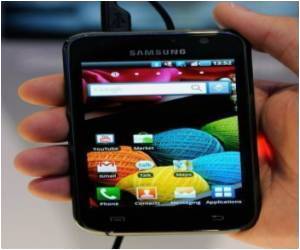The technology used with a smartphone is used to perform lab-grade medical diagnostic tests such as ELISA.
Highlights
- A technology has been developed that enables smartphone to perform medical diagnostic tests.
- The spectral transmission-reflectance-intensity (TRI)-Analyzer can assess patient blood, urine, or saliva samples as reliably as clinic-based instruments.
- The TRI-analyzer is capable of achieving limits of detection that are comparable to those obtained for the same assay measured with a conventional laboratory microplate reader.
The TRI analyzer utilizes the internal rear-facing camera as a high-resolution spectrometer. The inbuilt spectrometer measures the colorimetric absorption spectrum, fluorescence emission spectrum, and resonant reflection spectrum from a microfluidic cartridge inserted into the measurement light path.
Light source from either the white “flash” LED of the smartphone or an integrated green laser diode was used to direct illumination into a liquid test sample or onto a photonic crystal biosensor.
A diffraction grating placed directly over the smartphone camera received the light emerging from each type of assay via optical fiber and as spectra is generated.
The spectra is associated with a unique configuration of a microfluidic “stick” containing a linear array of liquid chambers that are swiped through the instrument while the smartphone captures video and the software automatically selects spectra representative of each compartment.
The system was tested for representative assays in the field of point-of-care (POC) maternal and infant health. An ELISA assay for the fetal fibronectin protein which is used as an indicator for pre-term birth and a fluorescent assay for phenylalanine which indicate phenylketonuria was assessed.
"Our TRI Analyzer is like the Swiss Army knife of biosensing," said Cunningham, the Donald Biggar Willett Professor of Engineering and director of the Micro + Nanotechnology Lab at Illinois. "It's capable of performing the three most common types of tests in medical diagnostics, so in practice, thousands of already-developed tests could be adapted to it."
By using a microfluidic cartridge that slides through an opening in the back of the cradle the TRI Analyzer can simultaneously measure multiple samples. The analyzer is suitable to analyze multiple samples quickly and can be used for patients who lack convenient access to a clinic or hospital with diagnostic test facilities or for patients with urgent health situations requiring rapid results.
"Our Analyzer can scan many tests in a sequence by swiping the cartridge past the readout head, in a similar manner to the way magnetic strip credit cards are swiped," said Long.
Cost-Friendly Device
The spectral transmission-reflectance-intensity (TRI)-Analyzer which functions as reliably as clinic-based instruments that cost thousands of dollars is made affordable for only $550.
"The TRI Analyzer is more of a portable laboratory than a specialized device," said Kenny Long, an MD/PhD student and lead author of the research study.
In addition to its applications in health diagnostics, Cunningham said the TRI Analyzer can also be applied to point-of use applications that include animal health, environmental monitoring, drug testing, manufacturing quality control, and food safety. The patented technology is available for license.
Reference
- Brian T. Cunningham et al., Multimode smartphone biosensing: the transmission, reflection, and intensity spectral (TRI)-analyzer, Lab on a Chip (2017) http://dx.doi.org/10.1039/C7LC00633K.
Source-Medindia










